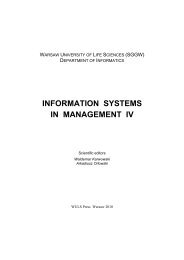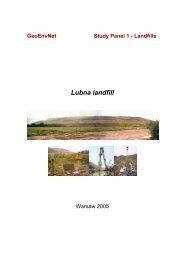ACTA SCIENTIARUM POLONORUM - SGGW
ACTA SCIENTIARUM POLONORUM - SGGW
ACTA SCIENTIARUM POLONORUM - SGGW
Create successful ePaper yourself
Turn your PDF publications into a flip-book with our unique Google optimized e-Paper software.
Economic Policy in Central Eastern Europe: Unit Root Consequences 63[Snowdon and Vane 2005, p. 303] caused by a series of permanent shocks. Thus, eachproductivity shock is permanent and determines a new growth path.Now, if the issue concerns the justification or legitimacy of economic policy interventionsthan the question is whether output is trend stationary or difference stationary.Snowdon and Vane [2005] state:“If business cycles are temporary events, then recessions create no long-run adverseeffects on GDP. However, whereas Keynesians feel that such deviations could be severeand prolonged and therefore justify the need for corrective action, monetarists, and especiallynew classical economists, reject the need for activist stabilization policy, havinggreater faith in the equilibrating power of market forces and rules-based monetary policy”[Snowdon and Vane 2005, p. 300].In order to determine whether economies need corrective actions, a distinction mustbe made as to whether outputs are difference stationary or trend stationary. In other words,do outputs fluctuate around deterministic trend or are they purely stochastic without anyclear trend? More precisely, in order to answer the question we need to prove if the equation3 contains a unit root.GDPt GDP t= GDP + a t + a + ε[3]0 2 1 −1 tNelson and Plosser’s groundbreaking study [1982] indicates that the U.S. GDP ispurely stochastic without any stable trends. On base of the Dickey-Fuller test [Dickey andFuller 1979], they were not able to reject the null hypothesis of unit root in the case of realGNP, nominal GNP, industrial production, and unemployment rate of the United States.In particular, non-rejection of unit root in the case of real GNP had very strong influenceon theoretical macroeconomics as well as on practical macroeconomic policy.“The most important implication of the unit root revolution, is that under this hypothesisrandom shocks have a permanent effect on the system. Fluctuations are not transitory.This implication, as forcefully argued by Nelson and Plosser, has profound consequencesfor business cycle theories. It runs counter to the prevailing view that business cycles aretransitory fluctuations around a more or less stable trend path” [Perron 1989, p. 1362].Many other studies dealt with the unit root testing by using U.S. data, as for instance,Rudenbusch [1992], Simkins [2001] or Andreou and Spanos [2003]. Furthermore, Fleissigand Strauss [1999] applied panel unit root tests to examine if real per capita GDP forOECD economies are trend or difference stationary. They conclude that the results failto reject the null hypothesis of unit root. Similarly, Narayan [2006] explored per capitaincome of G7 countries in the period 1870–2001. He was able to reject the unit root hypothesisin case of five countries of G7. Smyth and Inder [2003] used real GDP per capitain 25 of China’s provinces to test the unit root. They concluded that the evidence supportsthe unit root hypothesis if they allowed no structural breaks or one structural break. Incase of more than one break and in case of breaks in intercept and slope the results weremixed. Li [2000] examines China’s output data and concludes that the data are “flexibletrend stationary rather than difference stationary” [Li 2000, p. 825]. However, thesestudies have not examined economies the Central and Eastern Europe and the aim of thispaper is to provide an extension of previous studies to the CEE4.Oeconomia 10 (1) 2011
















